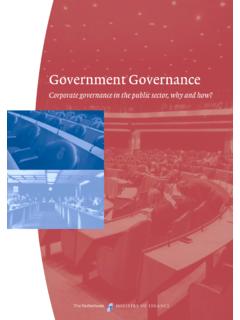Transcription of GOVERNMENT OF INDIA MINISTRY OF POWER
1 GOVERNMENT OF INDIA . MINISTRY OF POWER . SHRAM SHAKTI BHAWAN. RAFI MARG. NEW DELHI 110 001. P. Abraham Secretary No. C-286/95-IPC 10th November, 1995. Subject: Setting up of POWER plants of capacity 1000 MW or more supplying POWER to more than one State. 1. When the private policy was initiated during 1991-92, it was envisaged that these would be basically state projects selling POWER primarily to the state grid. A number of proposals were received and many of them are at various stages of finalization. However, it needs to be recognized that in order to improve the POWER supply, we would have to set up more than 10,000 MW of the capacity every year in the next few years, which is an onerous task. Moreover, the fuel for such thermal POWER plants coal is basically located in Eastern and Central INDIA , whereas the Hydel POWER potential is concentrated in the North east and North but higher demand for POWER is in the South and West.
2 It is therefore, obvious that unless Mega POWER projects are set up in the region having coal and hydel potential, we would not be able to tackle the increasing demand for POWER on the most viable route. Establishing mega projects in the coastal regions based on imported coal also poses as a feasible option. 2. It is well known that the public sector does not have adequate resources for putting up the required incremental capacity and it was primarily for this reason that private POWER policy was introduced in order to attract domestic and foreign private investment. It is also a fact that the public sector does not have adequate resources for putting up additional coal mining capacity required to match the incremental generation requirement. Therefore, the MINISTRY of POWER had been exploring the possibility of setting up mega POWER projects through the private route and the initial response has been positive.
3 When the mega projects come up in the private sector they would mostly also be composite proposals and include the scheme for development of the linked coal mine as well in many cases. This would be an additional advantage. 3. The state in which the mega project is set up may not always be able to absorb the total POWER would have to be wheeled to other states in the same region or in other regions in the country. This would require the promoters to enter into POWER purchase agreements with different states. Since it'll involve number of states it would not be, perhaps, possible for one state to initiate such mega POWER projects and it would be desirable to have a Central organization who could play a coordinating / fascinating role and provide escort services to the promoter. This matter has been discussed at great length with Central POWER Sector Utilities and the private POWER sector representatives and, based on these discussions, the GOVERNMENT has decided on the following broad policy.
4 A) Projects of capacity of 1000 MW and more and catering lower to more than one states should be considered as a mega project projects which cater POWER to a single state, irrespective of size, would not come under this category. b) There would be total transparency in selection of the promoters and the competitive bidding route would be followed issue of Request For Qualification' (RFQ), short listing of potential developers, inviting Request For Proposals' (RFPs) etc. the projects would not be awarded on the basis of negotiations with one party. This activity will be undertaken by POWERGRID. POWERGRID would also provide escort services, act as a facilitator and catalyst, arrange for wheeling of POWER generated by these mega projects and enter into separate agreement with the user SEBs/States on transmission Tariff. However, the developer would have to enter into separate POWER Purchase Agreements with the Purchasing States.
5 C) The CEA would identify potential sites for setting up such mega projects and NTPC would prepare feasibility reports (FRs), the cost of which could be recovered from the private promoter(s) and POWERGRID would take measures for selection of promoters and help in finalising PPAs between the promoter and the SEBs. This is for your kind information. With regards Yours sincerely Sd/- (P. Abraham). To: All chief Secretaries CC: 1. Shri Rajendra Singh, CMD, NTPC, New Delhi. 2. Shri Parekh, CMD, POWERGRID,New Delhi. MEGA POWER PROJECTS: REVISED POLICY GUIDELINES. The guidelines for setting up of mega POWER projects of capacity 1000 MW or more supplying POWER to more than one State had been issued vide letter No. C - 286/95-IPC, dated 10th November 1995 after considering the experience of this policy, the policy has been recast and is summarized below.
6 1. Inter-state and Inter-regional mega POWER projects are proposed to be set up both in the public and private sectors. In the public-sector, the National Thermal POWER Corporation (NTPC) and Damodar Valley Corporation (DVC) would be setting up the following projects: Kahalgaon Stage II (1500 MW), Maithon Project (1000 MW) and Cheyyur (1500 MW) In addition, NTPC would be expanding the four gas based plants, namely, Anta, Auriya, Kawas and Gandhar to an additional capacity of 1300 MW each. The National Hydro-Electric POWER POWER Corporation (NHPC) would be taking up the following Inter-state projects Koel-Karo (710 MW) Chamera-II (300 MW), Teesta-V (510 MW). Koldam (800 MW) and Parvati (800 MW). In the private sector, in addition to Inter-region Hirma (6X600 MW) project in Orissa, the following projects are also proposed to be taken up: Cuddalore (1000 MW) based on a blend of domestic and imported coal; Pipavav (2000 MW) based on imported coal and Narmada (1000.)
7 MW, which could be expanded to 2000 MW), based on LNG. Two or three more projects based on LNG, may be developed on the Western coast later. These fuel options can be revised based on feasibility and cost. 2. The Standing Independent Group (SIG) which had been constituted by the GOVERNMENT of INDIA in November, 1997, to establish parameters for negotiation of large POWER generation projects would initially be the apex body to oversee the implementation of the mega private POWER projects. The principles of competitive bidding would be adhered to as far as possible, while obtaining tariff offers. 3. A POWER Trading Corporation (PTC) would be established with majority equality participation by POWER Grid Corporation of INDIA Ltd. (PGCIL), along with NTPC, POWER Finance Corporation (PFC) and other financial institutions. Concerned State Governments/State Electricity Boards (SEBs) would also be co-opted, if found feasible.
8 The PTC would purchase POWER from the identified private projects and sell it to the identified State Electricity Boards. As POWER would be sold to the States. The concurrence of the concerned State Governments would be taken. Security to the PTC would be provided by means of a letter of Credit and resource to the state's share of Central Plan Allocations and other devolutions. However PTC may also, if feasible, supply POWER directly to a cluster', like licenses and industrial establishments. The setting up of PTC would enable mega-projects risk regarding payments. Such security would substantially bring down the tariff from such projects. 4. A pre-condition would be that the beneficiary States should have constituted their Regulatory Commissions with full powers to fix tariffs as envisaged in the Central Act. They would also have to privatise distribution in the cities having a population of more than one million.
9 Similar comforts would be given to public sector projects; however, they would deal directly with SEBs and not through the PTC. 5. The import of capital equipment would be free of customs duty for these projects. In order to ensure that domestic bidders are not adversely affected, price preference of 15% would be given for the projects under public sector, while deemed export benefits as per the EXIM policy would be given to domestic bidders for projects both under public and private sector. The domestic bidders would be allowed tc quote in US Dollars or any other foreign currency of their choice. In addition, the income-tax holiday regime would be continued with the provision that the tax holiday period of 10 years can be claimed by a promoter in any block of 10 years, within 15 years. The State Governments are requested to exempt supplies made to mega POWER plants from sales tax and local levies.
10 6. All such measures and the economies of scale in mega projects would substantially bring down tariffs from such identified mega projects to provide much needed relief to State Electricity Boards from rising tariffs from generating stations, both in public and private sectors. The policy would also enable implementation of a policy where large projects are set up at viable pit head sites, coastal locations and hydel source, thus eliminating the unnecessary as these projects would help in catalysting State electricity Boards and would also help to accelerate the establishment of systems that would transfer POWER across states and regions. 7. The projects would be offered to the developers only after all the clearances/land have been obtained so that projects can start soon after they are granted to the most competitive bidder. The environmental clearance would be given in two phases by the MINISTRY of Environmentanl Forest The site clearance being given initially.







